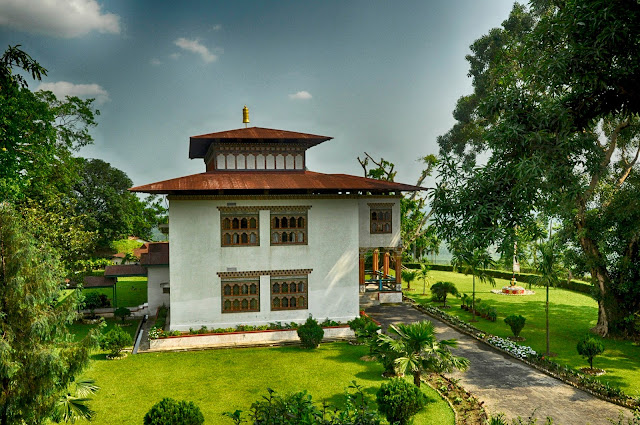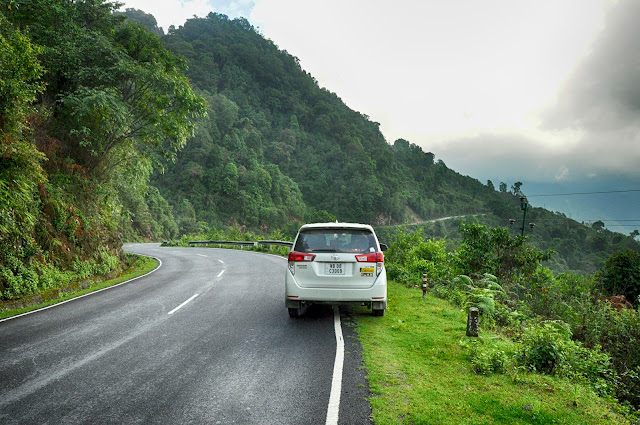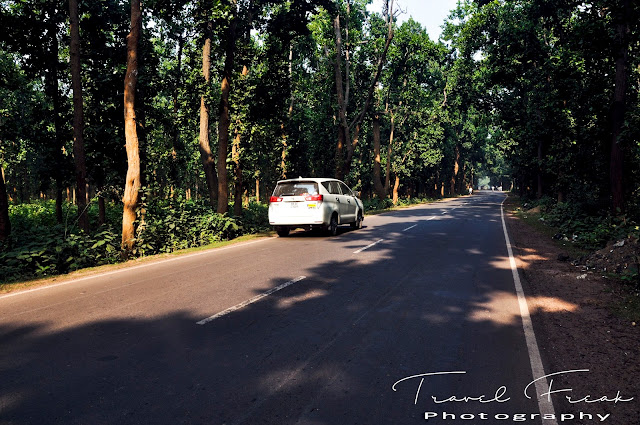Photo story of the Land of Shangri - la
Some tempting picture
 |
The Young Monk |

View of Haa Valley
 |
| Somewhere in Haa Valley |
 |
| White Monastery (Haa Valley) |

Another view of Haa Valley
 |
| Haa Valley |
 |
| A small monastery |

Yours Truely
One fine morning my daughter asked me ' Papa what is Shangri-La. Our teacher said that it is a permanently happy land, isolated from the outside world. The people who live at Shangri-La are almost immortal, living years beyond the normal lifespan and only very slowly ageing in appearance.Please papa I want to visit the real Shangri - La. And I promised her that our next travel destination will be the 'Land of Shangri - la ' . The mystical land complete with Tales of Shangri-La & Dragons with an abundance of wildlife with forest cover almost everywhere; abode of peace at the ‘Lakhang’ with age-old practices of Tibetan Buddhism; curvy and picturesque mountain roads dotted with ‘Chortens’ , high mountain passes with white flags against the blue mountains and snow caps; the magnificent ‘Dzong’( Monastic Forts) for administration and justice; men and women dressed in ‘Gho’ and ‘Kira’ respectively…
Yes!!! That’s a small glimpse of the small Himalayan kingdom known as Bhutan.
Something unique about this hidden Shangri-La
Country where every foreigner (except Indian) has to pay a steep royalty for their travel and stay in Bhutan.
A country that has no traffic lights - and the traffic is regulated by free flowing traffic circles.
No newspapers printed on a Sunday or nor do they want to read it. Isn't that cool!
No desserts, Lots of Chilly - May be it is the only country in the World where Chilly is the favourite veggie and there is nothing called a dessert in their daily menu. And of course Tea with Salt is quite popular.
They believe modernisation does not necessarily mean Westernisation.
Bhutan has never been colonised - no wonder then, they staunchly practise and protect their centuries old un-spoilt Buddhist culture. The efforts are on to ensure that the village culture is retained at all cost.
Indians need no visa to go to this Shangri-La and you could just drive into Bhutan in your own car, as you would do in a remote state in India ( say Ladakh and North East).
Overall, 75% of the population is Buddhist, about 23% is Hindu, 1.6% muslims and 0.4% other religions.
 |
Monastery Of Phuntsholing |
 |
Member of Crocodile Park, Phuntsholing |
Some common itinerary of Bhutan :
Day 1 : Kolkata to Hasimara by train then reached at Phuntsholing / Jaigaon . Distance between hasimara to Phuntsholing is about 20 km and it will take half an hour
Day 2: After complete all the immigration formalities from Phuntsholing immigration office statrt towards Timphu. It will take generally 6-7 hours .
Day 3 : Extent your permit for Punakha. Then complete the Thimphu Sightseeing
Day 4 : Thimphu to Punakha . It is near about 90 km and takes 3.30 hours. visit Punakha Dzong
Day 5 : Punakha to Paro. It is 180 kms. and take nearly 6-7 hours.
Day 6: Paro Sightseeinng
day 7 : Paro -CheLa La Pass - Haa Valley - Paro . Anyone can stay at Haa also . There are some basic accommodation at haa
Day 8 : Paro to Hasimara. Then back to Kolkata.
Day One : -
Phuntsholing to paro :-

Phuntsholing Border gate
| Beautiful Chorten welcomes you at Bhutan |
 |
| On the way to Paro Valley |
 |
| Another breathtaking place near Paro |
 |
| Night View of Paro dzong |
day 2 : It is a rainy day and a spectacular view of Paro City makes us lazy. Finally after having our breakfast , we started for our first sightseeing destination Kichu Lakhang at around 10:30 AM and it took us around 10 minutes to reach..it is one of the oldest and most sacred shrines of the Kingdom dating back to 7th century.
 |
| Entrance of Kichu lakhang |
 |
| Another view of Kichu |
 |
| Orange tree with full of Oranges |
 |
| Inside kichu |
After Kichu Lakhang, we we went to Paro Dzong. the Dzong houses the monastic body of Paro, the office of the Dzongda (district administrative head) and Thrimpon (judge) of Paro district. The approach to the Dzong is through a traditional covered bridge called Nemi Zam. A walk through the bridge, over a stone inlaid path, offers a good view of the architectural wonder of the Dzong as well as life around it. It is also the venue of Paro Tshechu, held once a year in the spring.It took us more than an hour to check in and out of the Dzong. And finally its time for lunch . So we back to Paro Market awhich is 10 minutes driving distance from Dzong and choose a clean hotel for Lunch.
After having Lunch, we thought of checking out Paro. The whole town is based on two parallel roads which would hardly be one KM. So we start a lazy drive around Paro city.
 |
| Paro Dzong |
 |
| Beside Paro Chu |
 |
| Entrance of Paro Dzong |
 |
| Another beautifull place near Paro city |
 |
| Beautiful Paro |
 |
| A small but beautiful monastery near tiger Nest base point |
 |
| A small but beautiful monastery near tiger Nest base point |
The central shrine in Lhakhang Nagpo is said to have no difference with that of Lhasa JOWO in Tibet. The construction of the Lakhang Karpo is believed to have been assisted by the locality. As a result the place came to be locally known as "Hay" meaning" surprise" which later became "Haa" due to the differences in interpretations and pronunciations of different people over time.
The three giant hills looming over the fringes of Haa valley were called "Me Rig Puen Sum" especially after the incidence of the Lhakhang Karpo construction. Today the three hills are popularly known as "Rig Sum Goenpa" signifying three deities-Jambayang Chana Dorji and Chenrizig.
Later, other Buddhist saints like Guru Rinpoche and "Machi Labdorn" came to the Jungney Drag in Haa and blessed the locality. The principal religion followed is Drukpa Kagyupa. After the arrival of Shabdrung Ngawang Namgyel, the chief guardian deity of Haa became, Ap Chundu.
Later in the afternoon drive back to Paro with an another way . The drive will be under 3 hours.
 |
| Life is too short to be normal..Stay weird |
 |
| Paro Airport |
 |
| Another breathtaking shot from Bird's eye view |
 |
| Paro Airport From Bird's eye view |
 |
| Not until we are lost do we begin to understand ourselves ( Just reaching Chela La ) |
 |
| Same place when i visit in winter ( Just reaching CheLa La) |
 |
| Highest Motorable road of Bhutan |
 |
Colourful prayer flag at Chela La |
 |
Another View of Chela La |
 |
Some where between haa to Chela La |
























Comments
Post a Comment